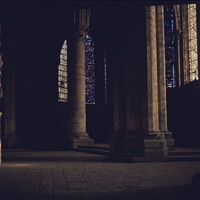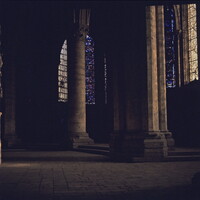| dc.description | The cathedral, built of limestone, is c. 34 m high and 130 m long internally. It has a four-bay choir with double aisles and a double ambulatory with six radiating chapels, of which three are shallow and three, reflecting the surviving crypt chapels, are deeper. The transepts have three bays with east and west aisles; the six-bay nave has single aisles and a western block with two towers. The elevation is three storeyed, with piliers cantonnés for the main piers, a narrow triforium and a clerestory that was unprecedently high.
(a) Before 1194.
Apart from Fulbert’s crypt the earliest part of the cathedral is the west end. Architecturally, its most prominent features are the two towers. These were conceived separately and imply two phases spread over a long period of time. A new tower, at the north-west, is mentioned c. 1140. For it to be built at all, Fulbert’s tower porch had to be removed; this is usually explained by a fire in 1134, even though the cathedral was said to have been spared. This new tower was originally free-standing and gave access via a long passage to the crypt, where a new statue of the Virgin had recently been displayed. The east end was altered at the same time, perhaps on the model of Saint-Denis Abbey. These works must also have included a new façade for Fulbert’s nave, but its form is not known. A few years later the south-west tower was built and the west front moved forward to its present position. The south-west tower was stylistically a major advance on its companion, which had been designed in the Romanesque manner for a wooden superstructure. This was replaced in the 16th century by Jehan de Beauce’s elegant Flamboyant spire. The extension of the nave brought the plan of the cathedral (apart from the transepts) up to its present limits.
(b) 1194 and after.
The damage inflicted by the fire of 1194 is hard to assess, although contemporary chroniclers indicated that it was total. It is possible that the wooden roof of the nave burnt, rather as in the choir of Canterbury Cathedral in 1174, but at Chartres the opportunity was taken to build a brand new cathedral on the old foundations. There was, however, a considerable but concealed element of continuity, which can be detected in the persistence of particular dimensions, perhaps even in the general character of the elevation. These imposed restraints on the Gothic architect and weighted the scales in favour of certain possibilities put to him, facts that have been obscured by the common opinion that Chartres opened a new era in the history of Gothic architecture. In 1194 Chartres was geographically some distance away from the main centres of architectural activity and stylistic research. It was on the wrong side of Paris, and its connections with the Loire Valley, which had contributed much to the 12th-century campaigns, were no longer much use as a source of inspiration. In the past this isolation gave rise to some serious scholarly misconceptions. Chartres was often treated as though it had no antecedents but was the result of a superhuman feat of imagination (the myth in its art-historical form); in fact, it emerged almost inevitably out of developments taking place in the regions of Laon and Soissons. Chartres belongs to the category of three-storey churches that included several churches at Laon, Soissons and Braisne, which might be described as Laon Cathedral with the gallery omitted. The distinctive feature is the triforium; otherwise the formula was common throughout the 12th century for middle-order churches (e.g. the choirs of Saint-Denis Abbey and Canterbury Cathedral). Even among churches of the largest category the four-storey elevation was in fashion for a comparatively short period of time. Where Chartres broke new ground was in simultaneously increasing the scale and reducing the number of storeys.
The debt to Laon Cathedral is most apparent in the vicinity of the transept, which is the only modification to the inherited plan. Two of the eleven bays of Fulbert’s church were assigned to the crossing, leaving four for the choir and the other five for the nave. The 12th-century addition became part of the nave and the whole extension was treated as four bays for vaulting purposes. Originally there was to have been a crossing tower, as at Laon, but this was abandoned before it was built. The change may be connected to the decision to extend the transepts and treat them as fully fledged, two-tower façades with triple portals and rose windows, more in the manner of the west front of Laon Cathedral than the transepts there.
The feature that distinguished the Gothic cathedral from both its own predecessor at Chartres and its immediate antecedents elsewhere was the huge glass-casket type of clerestory. To ensure the stability of this daring innovation, flying buttresses had to be used as they had never been used before, and eugène-emmanuel Viollet-le-duc found at Chartres the first canonical embodiment of his definition of Gothic architecture as the conjunction of pointed arches, ribbed vaults and flying buttresses. Such a technical appreciation was valid but perverse. It is true that by comparison with a cathedral such as Laon, Chartres is a monumental simplification, but the structural dexterity that made it possible was not something exploited for its own sake. Although strictly speaking a separate entity, the triforium hardly obtrudes. The effect, of two storeys separated by a narrow band, cannot have been very different from that of Fulbert’s nave, which comprised an arcade and a clerestory probably separated by a string course. In view of the apparently deliberate reuse of dimensions from the old building, it is reasonable to suppose that some attention was given to evoking further recollections of it when decisions were made about the general aspect of the new. This leads to the conclusion that Gothic Chartres was meant to be an enlarged version of Fulbert’s. The primary purpose of the exercise, however, was far more definite. The elevation is almost entirely occupied by two rows of enormous windows. The architecture is nothing but a frame for displays of stained glass. No light is admitted into the building without being filtered through colour, and the effect succeeds because every window in the church is fully glazed with the same type of glass. How long it took medieval church designers to discover that this was the essential condition of making the translucence of stained glass effective is not known; but Chartres is the only existing great church where the idea has been allowed to take charge, and there cannot have been many previous examples. The 12th-century cathedral may have been one of them. It was possible to design such a church only if it were known in advance that every window was paid for. The list of sponsors should have been fully subscribed before the architect was allowed to go ahead with such a revolutionary project. The result remains to this day quite stunning. There is nothing quite like Chartres, partly because of the sheer quantity of glass, partly because of its special tonal quality.
The price paid for this achievement was considerable. The masonry of Chartres is not noted for its finish. The crocket capitals are crude, and it is charitable to assume that they were not expected to be visible in the darkened interior. The structure, as befits a daring experiment, erred on the side of caution. The arcades carry much unnecessary weight, and the building is over-buttressed, especially along the nave. Later buildings refined these qualities. Although French cathedrals were never the same after Chartres, none of them has its robust, strictly functional style of architecture.
The design may have been adventurous, but it was quickly executed. During the 1950s there was a celebrated argument as to whether the cathedral was built from east to west (Frankl) or from west to east (Grodecki). Evidence pointed both ways. The issue was eventually settled by Canon Delaporte of Chartres, who showed that work began in the vicinity of the crossing, that the nave was earlier than the choir and the eastern part of the nave earlier than the western part. Since then van der Meulen has proposed that a new west front was intended and was eventually transferred to the south transept, which had to be extended and enlarged to accommodate it.
Despite variations of detail, the basic design was followed throughout. Like the cathedrals of Reims and Amiens there was a labyrinth in the pavement of the nave, but the names of the masons were not recorded in it. The choir was in use by 1221, and the whole cathedral consecrated in 1260. In 1316 the cathedral was the subject of an expert appraisal by Raymond du Temple, which recommended that the buttressing should be reinforced. Although in the past it was presumed that the top bank of nave fliers abutting the cornice was added at that time, it seems likely that it is original. High fliers had nothing to do with buttressing vaults. The top banks were introduced to lessen the risks imposed on a tall clerestory by wind pressure and vibrations transmitted from high-pitched roofs.
The last major additions to the fabric were the chapel of St Piat, added next to the axial chapel in the 14th century, and the spire of the north-west tower, begun in 1507 by Jehan de Beauce. In 1514 the choir was enclosed by a magnificent set of carved reliefs. These survived a Baroque refurbishing of the choir in 1763, but the 13th-century choir-screen across the entrance was a casualty (fragments in the chapel of St Piat). Chartres escaped serious attention from the Huguenots in the 16th century and suffered less than most cathedrals during the Revolution, although some of its precious relics, including the statue of the Virgin, were destroyed. In 1836 the medieval roof burnt. This started a series of restorations that began with the appointment of Jean-Baptiste-Antoine Lassus and Emile Boeswillwald as cathedral architects in 1846 and lasted intermittently for the rest of the 19th century; since then archaeological curiosity has prompted several excavations. The most pressing problem is the threat to the glass posed by atmospheric pollution. Measures to protect it have been taken; whether they will prove effective remains to be seen. (PETER KIDSON: 'Chartres', The Grove Dictionary of Art Online, ed. L. Macy (Accessed [7/1/2003]) <http://www.groveart.com>)
"Chartres Cathedral was rebuilt after a fire in 1194 and completed c. 1220, incorporating substantial remains of the previous church. The extensive crypt (9th-12th century) was left intact, but slightly extended to support the new choir above it. The western nave bay, two west towers, and much of the west front, of early Gothic date (c. 1135-60), were also undamaged, and retained in the present building. Resources came from the pilgrims who flocked to visit the Robe of the Virgin, the cathedral's most treasured possession. Chartres was designed as a pilgrimage church, with broad aisles, doubled in the choir, for easy circulation, and enormous aisled transepts with triple portals and porches to rival the west front. The aisles are of equal height, not stepped like Bourges. All vaults are quadripartite, that of the nave some 37 m (120 ft) high. An arcade of alternately round and octagonal-cored 'piliers cantonnes' (piers flanked by four attached shafts), supports a band triforium and a clerestory with windows reaching down below the vault springings, and almost as tall as the arcade itself. The windows are of plate tracery, with a rosette set above twin lancets. Indeed, Chartres was almost designed around its windows. Vast rose windows decorate the west front and the two transept facades. The stained glass which fills the windows of Chartres is among the finest produced in the Middle Ages." (Banister Fletcher, "A History of Architecture", p. 394)UNESCO World Heritage Site, 1971
http://whc.unesco.org/en/list/81/ accessed 12/14/05 | en_US |



